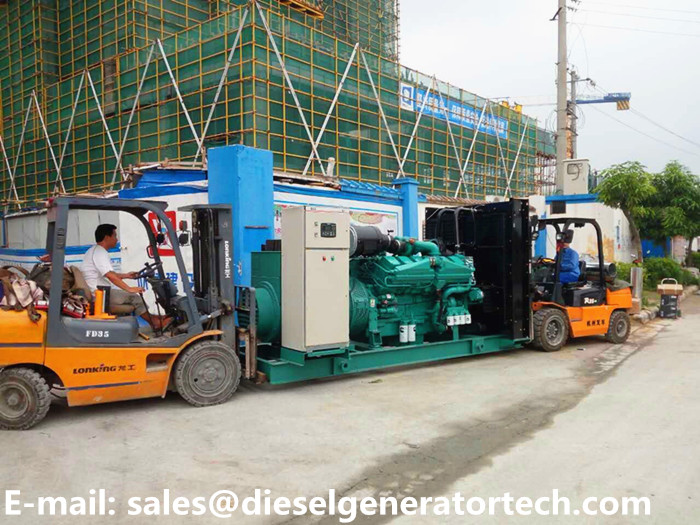As we know that engine maintenance is very important to prolong the service life of a diesel generator. However, providing and maintaining an adequate supply of clean, high-quality fuel, lubricating oil, grease and coolant in an engine is one way of ensuring long life and satisfactory performance. In this article, we mainly talk about Cummins engine lubricating, fuel and coolant.
The function of lubricating oil
The lubricating oil used in a Cummins engine must be multifunctional. It must perform the primary functions of:
Lubrication by providing a film between the moving parts to reduce wear and friction.
Cooling by serving as a heat transfer media to carry heat away from critical areas.
Sealing by filling in the uneven surfaces in the cylinder wall, valve stems and turbocharger oil seals.
Cleaning by holding contaminants in suspension to prevent a build up of deposits on the engine surfaces.
In addition, it must also provide:
Dampening and cushioning of components that operate under high stress, such as gears and push tubes.
Protection from oxidation and corrosion.
Engine lubricating oil must be changed when it can no longer perform its functions within an engine. Oil does not wear out, but it becomes contaminated to the point that it can no longer satisfactorily protect the engine. Contamination of the oil is a normal result of engine operation. During engine operation a wide variety of contaminants are introduced into oil. Some of these are:
Byproducts of engine combustion – asphaltense, soot and acids from partially burned fuel.
Acids, varnish and sludge which are formed as a result of the oxidation of the oil as it breaks down or decomposes.
Dirt entering the engine through the combustion air, fuel, while adding or changing lubricating oil.
The oil must have an additive package to combat these contaminants. The package generally consists of:
Detergents and dispersant which keep insoluble mater in suspension until they are filtered from the oil or are removed with the oil change. This prevents sludge and carbon deposits from forming in the engine.
Inhibitors to maintain the stability of the oil, prevent acids from attacking metal surfaces and prevent rust during the periods the engine is nor operating.
Other additives that enable the oil to lubricate highly loaded areas, prevent scuffing and seizing, control foaming and prevent air retention in the oil.

Oil performance classification system
Break-in oils
Special “break-in” lubricating oils are not recommended for new or rebuilt Cummins engines. Use the same lubricating oils used in normal engine operation.
Viscosity recommendations
The viscosity of an oil is a measure of its resistance to flow. Table 3-1 shows the viscosity range for these grades. Oils that meet the low temperature (0°F[-18°C] requirement carry a grade designation with a “W” suffix. Oils that meet both the low and high temperature requirements are referred to as multigrade or multiviscosity grade oils.
Table 3-1: SAE Viscosity Numbers for Lubricating Oils | |||
Viscosity Range | |||
SAE Viscosity Grade | Millipascal-second, mPa·s (centipoise, cP) @ 0°F[-18°C] | Millimetre2/second, mm2/·s (centistoke,cSt) @ 212°F[100°C] | |
maximum | minimum | maximum | |
5W | 1250 | 3.8 | -- |
10W | 2500 | 4.1 | -- |
15W | 5000 | 5.6 | -- |
20W | 10000 | 5.6 | -- |
20 | -- | 5.6 | Less than 9.3 |
30 | -- | 9.3 | Less than 12.5 |
40 | -- | 12.5 | Less than 16.3 |
50 | -- | 16.3 | Less than 21.9 |
1. SAE Recommended Practice J300d 2. 1 mPa·s = 1cP 3. 1 mm2/s = cSt | |||
Multigraded oils are generally produced by adding viscosity index improver additives to retard the thinning effects a low viscosity base oil will experience at engine operating temperatures. Multigraded oils that meet the requirements of the API classifications, are recommended for use in Cummins engines.
Cummins recommends the use of multigraded lubrication oil with the viscosity grades shown in Table 3-2. The table shows that Cummins viscosity grade recommendations at various ambient temperatures. The only viscosity grades recommended are those shown in this table.
Table 3-2. Viscosity Grade VS Ambient Temperature | |
SAE Viscosity Grade* | Ambient Temperature* |
Recommended | |
10W-30 | -13°F to 95°F [-25°C to 35°C] |
15W-40 | 14°F and above [-10°C and above] |
20W-40 | 32°F and above [0°C and above] |
40 | 50°F and above[10°C and above] |
*SAE-5W mineral oil should not be used. | |
Cummins has found that the use of multigraded lubricating oil improves oil consumption control, improving engine cranking in cold conditions while maintaining lubrication at high operating temperatures and may contribute to improve fuel consumption. Cummins does not recommend the use of single grade lubricating oils. In the event that the recommended multigrade oil is not available, single grade oils may be substituted.
Caution: When single grade oil is used, be sure that the oil will be operating within the temperature ranges shown in Table 3-3.
Table 3-3. Alternate Oil Grades | |
10W | -13°F to 32°F [-25°C to 0°C] |
20W | 23°F to 68°F [-5°C to 20°C] |
20W-20* | 23°F to 68°F [-5°C to 20°C] |
20 | 23°F to 68°F [-5°C to 20°C] |
30 | 39°F and above [4°C and above] |
40 | 50°F and above[10°C and above] |
*20W-20 is not considered a multigrade even though it meets two grades. | |
The primary criterion for selecting an oil viscosity grade is the lowest temperature the oil will experience while in the engine oil sump. Bearing problems can be caused by the lack of lubrication during the cranking and start up of a cold engine when the oil being used is too viscous to flow properly.
Copyright © Guangxi Dingbo Generator Set Manufacturing Co., Ltd. All Rights Reserved | Sitemap
Update cookies preferences